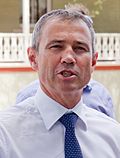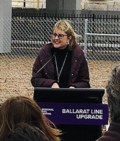Premiers and chief ministers of the Australian states and territories
In Australia, a Premier is the head of government of a state, while a Chief Minister is the head of government of a territory.
History and background
In colonial times, the five British colonies on mainland Australia, along with the Van Diemen's Land colony of Tasmania and the colony of New Zealand, had their own Governor, a title that eventually was changed to "Premier". Back then, the two territories did not exist, so the colonies represented what we today know as the six states and New Zealand, which is not part of Australia and now has a Prime Minister. Today, the Governor serves as the head of state of a state. The King is the head of state of Australia and is represented by the Governor-General when he is absent.
Until the creation of the Australian Labor Party (a centre-left, social democratic party), there were no political parties in Australia, so the Premiers were all independents.
On a federal level, Australia's head of government is called the Prime Minister. Because Australia formed as a federation of six British colonies, each state and territory has their own level of government, which is the second-highest level in Australia, the lowest being local government, which is made up of different councils.
Like the Prime Minister, Premiers and Chief Ministers are the state/territory leader of the party that forms government. Currently, the Labor Party forms a majority government in three states (Victoria, Western Australia and South Australia), as well as federally. In Queensland, the Liberal Party (a centre-right, liberal conservative party) currently governs with a majority. In New South Wales, the Labor Party governs in a minority government, with the support of three independents on confidence and supply, meaning they can vote differently to the Government but still allow them to govern. In the Australian Capital Territory (ACT), the Labor Party also governs in a minority government. In Tasmania, the Liberal Party governs in a minority government with support from four independents, two of whom were members of the Jacqui Lambie Network until they were expelled from the party by party leader Jacqui Lambie.
When a party is unable to win a majority of seats in the Lower House, the party with the most seats must seek support from the crossbench. A crossbencher is someone who is not from either the Government or the Opposition. Then they can form either a coalition government with the crossbenchers or they crossbenchers can give them confidence and supply. For example, it is very common federally and in New South Wales and Victoria for the Liberal Party and the National Party to form a coalition, regardless of if they are in Government or Opposition. This is commonly called the Coalition.
In Queensland and the Northern Territory, these two parties merged to become the Liberal National Party (LNP) and the Country Liberal Party (CLP), respectively. In Western Australia, it is common for the Liberals and the Nationals to form the Coalition, but the agreement is different there in that the parties are still independent of each other. In South Australia and Tasmania, the Coalition has existed before but currently does not exist, as the Nationals have not very much activity there and they have no seats in those states. In the ACT the Coalition does not exist, because the Nationals do not have a branch there, only the Liberals do. This is because the Nationals represent regional, rural and remote interests, called agrarianism, but almost all of the ACT is the city of Canberra.
Current premiers of the states and current chief ministers of the territories
| State | Portrait | Name | Term start | Current duration | Party | Title | State government | |
|---|---|---|---|---|---|---|---|---|
Territory |

|
Andrew Barr[1] | 11 December 2014 | 11 years, 14 days | Labor | Chief Minister | Aust. Cap. Territory | |

|
Chris Minns | 28 March 2023 | 2 years, 272 days | Labor | Premier | New South Wales | ||

|
Lia Finocchiaro | 28 August 2024 | 1 year, 119 days | Country Liberal | Chief Minister | Northern Territory | ||
| David Crisafulli | 28 October 2024 | 1 year, 58 days | Liberal National | Premier | Queensland | |||

|
Peter Malinauskas[2] | 21 March 2022 | 3 years, 279 days | Labor | Premier | South Australia | ||

|
Jeremy Rockliff[3] | 8 April 2022 | 3 years, 261 days | Liberal | Premier | Tasmania | ||
| Jacinta Allan[4] | 27 September 2023 | 2 years, 89 days | Labor | Premier | Victoria | |||

|
Roger Cook | 8 June 2023 | 2 years, 200 days | Labor | Premier | Western Australia | ||
Premiers And Chief Ministers Of The Australian States And Territories Media
References
- ↑ "Andrew Barr". ACT Labor. Retrieved 28 June 2022.
- ↑ "Premier of South Australia". Government of South Australia. Archived from the original on 26 June 2022. Retrieved 28 June 2022.
- ↑ "Jeremy Rockliff". Tasmanian Government. Retrieved 28 June 2022.
- ↑ "Premier of Victoria". Premier of Victoria. Retrieved 28 June 2022.




